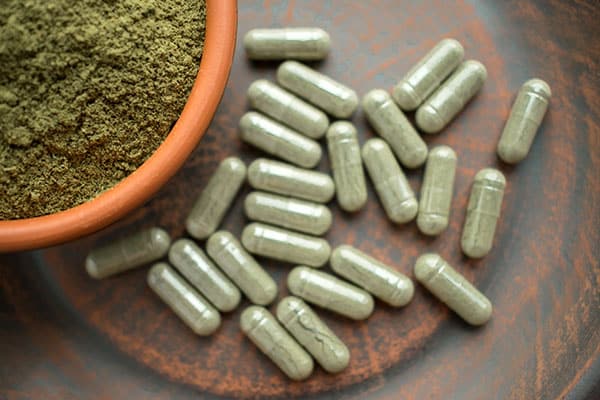Kratom has been at the center of a heated debate for years. Some people swear by it, calling it a natural remedy for pain, anxiety, and even opioid withdrawal. Others warn that it’s an unregulated substance with dangerous side effects and a high risk for addiction.
The truth is that kratom isn’t very well understood—and that’s part of the problem. While it’s widely available in the U.S., it isn’t regulated by the FDA, meaning there’s no oversight on its safety, purity, or potency. Some people report benefits, but many others experience dependence, withdrawal, and even serious health complications.
Before using kratom—or trying to quit—it’s important to understand how it works, as well as the risks involved in using it. In this guide, we’ll break down everything you need to know, including whether kratom is a safe alternative to opioids, why some people struggle to quit, and what to do if you or someone you love is dependent on it.
What Is Kratom?
“Kratom” refers to the leaves of Mitragyna speciosa, a tropical evergreen tree native to Southeast Asia. For centuries, people in the region have used kratom for its stimulating and pain-relieving effects, traditionally chewing the leaves or brewing them into tea.
In the U.S., kratom is more commonly found in capsules, powders, liquid extracts, and even energy shots—often sold in smoke shops and online.
Kratom’s effects come from two key compounds: mitragynine and 7-hydroxymitragynine, which interact with opioid receptors in the brain. At low doses (under 5 grams), it acts as a stimulant, increasing energy and alertness. At higher doses (5+ grams), it produces opioid-like effects, including euphoria, sedation, and pain relief.

This dual nature—part stimulant, part opioid—is part of what makes kratom so controversial. It fuels conflicting narratives about what the drug actually does, with proponents claiming it’s a harmless, natural stimulant, while opponents point to its opioid-like effects, dependence potential, and severe withdrawal symptoms—arguing that it should be regulated like traditional opioids.
Why Do People Use Kratom?
People turn to kratom for a variety of reasons, ranging from self-medication for a variety of ailments to recreational use. While some believe it offers a safe and natural alternative to pharmaceuticals, others use it to circumvent drug testing or as a substitute for stronger and more difficult-to-source substances, such as prescription painkillers or heroin.
Self-Medication for Pain, Anxiety & Depression
Many kratom users take it to manage chronic pain, anxiety, or depression without prescription medication. By interacting with the brain’s opioid receptors, kratom can temporarily relieve pain and discomfort while also producing a euphoric effect that may ease negative emotions. However, because it is unregulated and lacks standardized dosing, its effects are unpredictable, and long-term use can lead to dependence.
A Legal Loophole for Recreational Use
Unlike many other psychoactive substances, kratom is legal in most parts of the U.S. and is often sold at gas stations, vape shops, and online. It is sometimes used recreationally, especially by:
- Young adults looking for a legal high
- Individuals on probation or in the military who need to avoid substances that appear on standard drug tests
- People seeking a stimulant boost for work, studying, or social situations
Kratom as an Opioid Substitute or Self-Treatment for Withdrawal
Some people take kratom to help manage withdrawal symptoms from opioids like heroin, fentanyl, or prescription painkillers. While there are anecdotal reports of success, medical experts warn that kratom itself is addictive and that withdrawal from kratom can be just as difficult as withdrawal from conventional opioids.
For information on managing opioid withdrawal with approved medications, check out our page on buprenorphine (Suboxone, Sublocade, Subutex) treatment.
Does Kratom Work for Pain & Opioid Withdrawal?
One of the biggest debates around kratom is whether it’s a legitimate alternative for pain relief and opioid withdrawal—or if it’s just replacing one addictive substance with another.
Pain Relief: A Natural Alternative or a Risky Gamble?
Many kratom users swear by its pain-relieving effects, especially for conditions like chronic back pain, arthritis, and fibromyalgia. The active compound mitragynine binds to opioid receptors in the brain, producing similar effects to prescription painkillers—but without FDA regulation or medical oversight.
While some studies suggest kratom may have mild analgesic properties, medical experts warn that:
- Dosing is unpredictable—Too much can lead to sedation, nausea, and dependence.
- Potency varies—Different strains contain different levels of active compounds.
- Long-term use can lead to addiction—Regular users may develop tolerance, requiring higher doses for the same effects.
Opioid Withdrawal: Helpful or Harmful?
Kratom is often touted as a natural way to ease withdrawal symptoms for people trying to quit opioids. Some individuals report relief from nausea, anxiety, and muscle aches, but this approach comes with serious risks:
- Kratom activates the same opioid receptors as heroin and prescription opioids, meaning it can cause its own withdrawal symptoms when stopped.
- Some people end up dependent on kratom instead of quitting opioids altogether.
- Because kratom is unregulated, there’s no standardization for safety, purity, or effectiveness—some products are even laced with fentanyl or other synthetic opioids.
The bottom line? There’s no solid medical evidence that kratom is a safe or effective withdrawal aid—and professional treatment is the best option for long-term recovery.
For information about treating addiction to opioids, including prescription drugs and illicit drugs like heroin and fentanyl, check out our Opioid Addiction Treatment service page.
Is Kratom Addictive?
Kratom’s active compounds bind to opioid receptors, triggering the release of feel-good chemicals like dopamine and endorphins. Over time, the brain adjusts to the presence of kratom, leading to:
- Tolerance – Users need more kratom to achieve the same effects.
- Dependence – The body begins to rely on kratom to function normally.
- Addiction – The user experiences intense cravings and compulsive use, even when it causes harm.
Signs of Kratom Addiction
People who develop a dependence on kratom may experience:
- Increased use over time, despite negative consequences
- Cravings and preoccupation with obtaining or using kratom
- Difficulty stopping or cutting back without withdrawal symptoms
- Neglecting responsibilities at work, school, or home
- Spending excessive time and money on kratom
Is Kratom Withdrawal Like Opioid Withdrawal?
Yes. Since kratom affects the same brain receptors as opioids, withdrawal symptoms are similar—though often less severe. And, as with opioids, the intensity of withdrawal depends on how long and how much someone has been using.
Kratom Withdrawal: What to Expect & How to Manage It
Kratom withdrawal can range from mild discomfort to severe distress, depending on how long and how much a person has used. Symptoms typically start within 12-24 hours after the last dose and can last for several days to a week.
Physical Symptoms:
- Nausea, vomiting and diarrhea
- Muscle aches and joint pain
- Sweating and chills
- High blood pressure
- Fatigue and lethargy
- Tremors or involuntary movements
Psychological Symptoms:
- Intense cravings
- Anxiety and panic attacks
- Depression and mood swings
- Insomnia and restless sleep
- Irritability and agitation
Managing Kratom Withdrawal
For some, withdrawal symptoms can be managed at home, while others may need medical support to detox safely.
- Stay hydrated – Drink plenty of fluids to counteract sweating, vomiting, and diarrhea.
- Use OTC medications – Ibuprofen for pain, loperamide for diarrhea, and melatonin for sleep can help ease symptoms.
- Rest and eat well – A balanced diet and adequate sleep can help the body recover faster.
- Seek medical help if needed – Severe withdrawal symptoms, especially extreme anxiety or depression, may require medical detox to prevent complications.
When to Seek Professional Detox & Treatment
If withdrawal symptoms become too intense to manage alone or if someone has relapsed multiple times, a medically supervised detox program can make the process safer and more comfortable.
For information on medical detox and withdrawal management, check out our Drug & Alcohol Detox service page.
Health & Safety Risks Associated with Kratom
While kratom isn’t as well studied as traditional opioids, its lack of regulation and oversight makes it a risky choice—especially for long-term use. Beyond addiction and withdrawal, there are several other potential dangers to be aware of.
Lack of Quality Controls & Safety Standards
Unlike prescription medications, kratom products are not regulated by the FDA. That means there’s no guarantee of purity, potency, or safety. Some kratom products have been found to contain:
- Fentanyl and synthetic opioids – Making them far more dangerous than kratom alone.
- Synthetic cannabinoids – Causing unpredictable psychoactive effects.
- Heavy metals and toxins – Leading to long-term health complications.
- Bacterial contamination – Kratom has been linked to multiple salmonella outbreaks in the U.S.
Dangerous Drug Interactions
Kratom can be extremely risky when mixed with other substances, including:
- Alcohol – Increases the risk of liver damage and overdose.
- Benzodiazepines (Xanax, Valium, Ativan) – Can cause extreme sedation and respiratory depression.
- Antidepressants & stimulants – May lead to dangerous heart complications or serotonin syndrome.
Organ Damage & Long-Term Health Risks
While research is still limited, chronic kratom use has been linked to:
- Liver toxicity – Symptoms include jaundice, dark urine, and nausea.
- Cardiovascular issues – Increased heart rate and high blood pressure.
- Seizures – Especially when combined with other substances.
What Are Safer Alternatives?
If someone is using kratom for pain relief or opioid withdrawal, there are safer, evidence-based options available.
Non-Opioid Pain Management Options
For those using kratom for chronic pain, there are safe, non-addictive alternatives, such as:
- Physical therapy – Strengthens muscles and reduces pain over time.
- Anti-inflammatory medications – NSAIDs like ibuprofen or naproxen can provide relief.
- Acupuncture or chiropractic care – Some patients find relief through holistic treatments.
FDA-Approved Medications for Opioid Withdrawal
If the goal is to quit opioids, the best approach is to use medications that have been clinically tested and approved. These include:
- Buprenorphine (Suboxone) – Helps reduce cravings and withdrawal symptoms.
- Methadone – Used in structured treatment programs to manage long-term opioid dependence.
- Naltrexone (Vivitrol) – Blocks opioid receptors to prevent relapse.
Behavioral Therapies & Mindfulness Practices
If someone is using kratom to cope with anxiety, stress, or depression, therapy-based approaches can help address the root cause:
- Cognitive Behavioral Therapy (CBT) – Helps reframe negative thought patterns.
- Mindfulness & meditation – Can improve emotional regulation and stress management.
- Support groups – Programs like SMART Recovery provide peer support for substance-related struggles.
Getting Help for Kratom Dependence
Quitting kratom can be challenging, but help is available. Because kratom affects the brain in ways similar to opioids, stopping suddenly can cause severe withdrawal symptoms and cravings. The best way to overcome dependence is with a combination of medical care, therapy, and long-term support.
How Enterhealth Can Help
At Enterhealth, we take a science-backed, individualized approach to addiction treatment. Our inpatient and outpatient programs include:
- Medically supervised detox to manage withdrawal safely.
- Advanced behavioral therapy to address psychological dependence.
- Long-term recovery planning to prevent relapse.
Kratom addiction is real, but so is recovery. If you or a loved one is struggling, we’re here to help. Call 800.388.4601 or visit our contact page to learn more about treatment options.




